
Ask any 10-year-old what they want to be when they grow up, and chances are “an astronaut” is likely near the top of their list. For Michayal Mathew, a junior in the Department of Aerospace Engineering at Texas A&M University, that dream never faded with time. Spending much of his childhood in League City, Texas, Mathew visited Johnson Space Center so many times he memorized each exhibit, acting as his own tour guide. This summer he is one step closer to fulfilling his dream of one day going to space — at least virtually.
Mathew is working as a summer intern at NASA’s Goddard Space Flight Center in Greenbelt, Maryland. During the 10-week internship he will be gathering terrain data on the surfaces of Mars, the moon and some volcanoes on Earth, and mapping them in virtual reality. His work is laying the foundation for the technology that will one day train astronauts. And if Mathew’s lifelong dream comes true, he might even use the technology himself some day.
“Working at NASA has always been a dream,” he said. “I always appreciated airplanes, but then getting to see astronauts, I thought, ‘This is way cooler than being a pilot.’”
‘Patience, tenacity and continued hard work’
Mathew said his acceptance into NASA’s internship program was “pure luck.” Dr. Darren Hartl, assistant professor of aerospace engineering, disagrees.
“Michayal applied for a wide range of internships, from virtual reality software companies to airlines, and he received multiple ‘we regret to inform you’ communications,” Hartl said. “Patience, tenacity and continued hard work toward an increase in his capabilities eventually paid off when he was offered what was likely his first choice all along.”
Mathew works in Hartl’s lab, the Immersive Mechanics and Visualization Lab. Hartl hired Mathew when he was a freshman, citing his passion and self-motivation as his rationale for hiring someone with less academic experience than other applicants. The lab is developing methods to take computational data and use augmented reality and virtual reality to create an immersive learning experience.
According to Hartl, classrooms of the future will be better equipped thanks to virtual reality.
“Modern engineering is rich in three-dimensional or even higher-dimensional data, and virtual reality allows us to explore designs and 3-D spatial results in a much more intuitive way than is permitted on 2-D computer screens,” Hartl said. “The virtual reality software and hardware developers have done such a great job over the past few years in particular, and it is time for us in engineering research and education to take advantage of these new capabilities.”
Virtual reality and space exploration
This summer, Mathew is applying everything he has learned in Hartl’s lab and putting it to the test with his Mars exploration research. Mathew is working under his mentor, Dr. Brent Garry, a geologist at NASA.

“We’re using satellite images and putting a height to the terrain,” he said.
He’s also getting a first-hand look at the surface of the moon, the way Neil Armstrong and Buzz Aldrin saw it in 1969.
“I remade the Apollo 11 mission and can sit in a rover and drive it around,” he said.
Mathew has also mapped volcanoes on Earth, allowing geologists to view the inside of lava tubes long after they leave.
“The coolest thing is I’m phase one,” he said. “Whatever I do is going to set the basis for the future of the project. From the very beginning it starts with me and my mentor.
Mathew initially expected that he would merely be following around scientists and engineers during his internship. He didn’t anticipate that he would be responsible for such important work.
“Honestly it’s pretty surreal,” he said. “It’s crazy to come in every day. There are thousands of people working on this campus and they’re all working toward space research. I don’t have the words to describe it, but it’s definitely surreal.”
Mathew sees a future in virtual reality, and it’s one he didn’t anticipate when he first arrived at Texas A&M.
“Dr. Hartl’s research lab developed me into who I am,” he said. “It was the best decision I made.”
After he graduates, Mathew hopes to find work where virtual reality and aerospace meet. If he’s one of the lucky ones he’ll make it to space. Only this time he won’t be wearing goggles, he’ll be wearing a space suit.